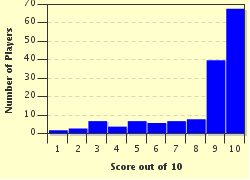Quiz Answer Key and Fun Facts
1. How often are federal elections held in Australia?
2. In an Australian federal election, we usually vote for two separate things. What are they?
3. How do we usually record our vote in an Australian election?
4. On which day of the week are Australian elections held?
5. What do many voters traditionally enjoy on election day throughout Australia?
6. Voting in federal elections is compulsory in Australia.
7. What is the legal voting age in Australia?
8. Which of these was the last group to gain full voting rights in Australia?
9. What counting system is used to determine the winner of a ballot in an Australian federal election?
10. In a normal federal election in Australia we vote for (roughly) half of the Senate. What is the name for an unusual election scenario where the entire Senate is replaced?
Source: Author
lorance79
This quiz was reviewed by FunTrivia editor
stedman before going online.
Any errors found in FunTrivia content are routinely corrected through our feedback system.

